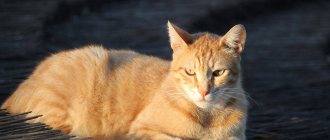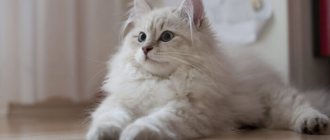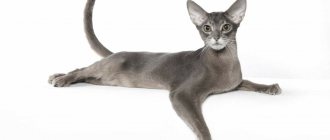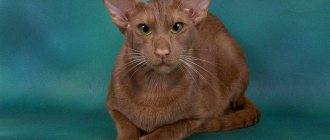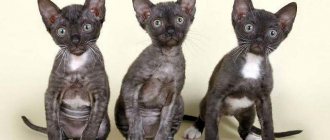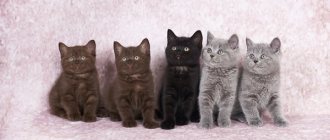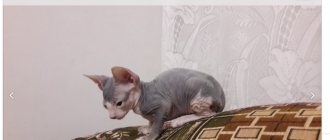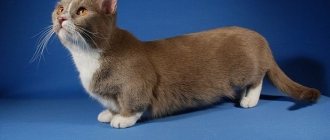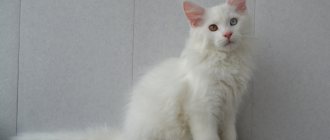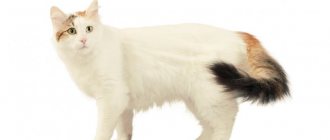How coat color is formed
As surprising as it may sound, the fur color of domestic cats is formed from only two primary colors: red and black. All other colors, except white, are just a combination of them. Moreover, the same gene is responsible for both black and red color in cats, existing in two alleles (forms):
- “O” - red (dominant allele);
- “o” - black (or rather, not red, recessive).
The color gene is located only on the X chromosome. In cats, ordinary cells contain, as is known, two of them. In cats, the set of chromosomes looks like this - XY. That is, in one of them (Y) the “O” (or “o”) gene is missing.
Accordingly, the genetic code of a female individual may look like this:
- “OO” - red coat color;
- "Oo" - tortoiseshell;
- "oo" - black (not red).
In this case, cat fur can only be:
- "OY" - red;
- "oy" - black.
Persian cat
These magnificent animals have a very long history. Their development began around the 16th century. The first representatives of this breed came to Italy from one of the Persian provinces. Subsequently, they gained extraordinary popularity among European breeders and quickly spread throughout the continent.
These animals have a memorable appearance. The average weight of Persians reaches 6-8 kilograms, but larger individuals are also found in nature. On a rounded head with thick cheeks, strong jaws, a powerful chin and a convex forehead, there are small ears, expressive shiny eyes and a short, upturned nose. The large body with a wide back and massive chest is covered with thick long hair. As for color, the standard allows several options. But black, white, red, blue, cream and brown cats are especially popular.
How to select manufacturers
Parents can thus have four color combinations to produce red kittens:
- both parents are red;
- red cat - tortoiseshell cat;
- black cat - a red cat;
- black cat is a tortoiseshell cat.
By crossing a red cat with a black cat, you can only get black and tortoiseshell kittens. In this case, genes can only be folded in the following way: Oo, oU.
For red cats and male cats, all kittens will thus be red (OO+OU). There is simply nowhere for black to come from here. In this case, only shades of red are possible - red or cream (dilute red).
A black cat and a red cat will give birth to red boys and tortoiseshell girls. This is explained by the fact that the combinations of genes in this case can only be the following: OU and OO.
A black cat and a tortoiseshell cat can give birth to both black and red boys. Girls will be black or tortoiseshell. The possible combinations of genes in this case are: OU, OO, OU, OO.
A red cat and a tortoiseshell cat will also give birth to both red and black boys. In this case, the girls will be motley or red. Colors in this case are determined by combinations of genes: Oo, OU, oU, OO.
As you may have noticed, red boys can be born in any of four possible combinations of parental colors. That is why there are much more ginger cats than pure red cats.
Drawing on the fur of cats
Cats of red and cream colors always have a pattern on their coat.
A variety of coat patterns allows you to get kittens with individual color characteristics. In order to obtain the desired color with the maximum probability, breeders study genetics and, based on new knowledge, look for parents for future offspring. Ordinary pet owners rarely think about the need for selection.
Tabby (tabby cats)
Tabby is the most common color of cats; this word also means the presence of a pattern on the coat - stripes or spots. Breeding such pets is difficult - the result can be quite unexpected.
Solid (solid) and smoky cats
If the cat is completely one color, this color is called solid. Such cats almost never have a pattern on their fur.
If the cat is black or blue, but the roots of the hair are clearly white - smoke (from English “smoke”). The roots of the hair of cats of the same color are usually greyish, but true “smoke” cats have distinct white roots, the color remaining only on the top part of the hair.
White marks
Cats of any color may have distinct white markings. The name of the color depends on their size and position.
Tortoiseshell cat color
Cats with similar coat colors have a combination of random spots of red and black throughout their body.
Color point
Cats of this color are characterized by darker areas than the main color at the end of the muzzle, tips of the ears, paws, and tail.
Cats of this color are born completely white and gradually darken. The older the animal, the darker the spots.
Colors accepted by the International Cat Federation (FIFe)
| Code | International color designation | Translation |
| A | Blue | Blue |
| B | Chocolate, brown, chestnut | Chocolate, brown, havana (champagne color) |
| C | Lilac, lavender | Lilac, lavender (platinum) |
| D | Red, flame | Red, fiery |
| E | Cream | Cream |
| F | Tortoise-shell, patch | Tortoiseshell, spotted |
| G | Blue-cream, blue-tortie | Bluish cream, bluish tortoiseshell |
| H | Chocolate-tortie | Chocolate tortoiseshell |
| J | Lilac-tortie | Lilac tortoiseshell |
| N | Black/ebony, seal, sable, ruddy | Black/ebony, seal, sable, wild |
| O | Sorrel, cinnamon, honey | Sorrel, red-brown (brown), honey |
| P | Beige fawn | Yellow-brown (“fawn beige”) |
| Q | Sorrel tortie | Red-brown tortoiseshell |
| R | Beige fawn cake | Tan tortoiseshell |
| S | Silver, smoke | Silver, smoky |
| U | Bronze | Bronze |
| W | White | White |
| Y | Golden | Golden |
| Z | Marble | Golden tortoiseshell |
| X | Unregistered | Unregistered, unrecognized color |
Color patterns adopted by the International Cat Federation (FIFe)
| Code | International designation | Translation |
| Presence of white in color | ||
| 01 | Van | Wang |
| 02 | Harlequin | Harlequin |
| 03 | Bicolour | Bicolor/bicolor |
| 04 | Mitted/white point | With white markings for color points |
| 09 | Little white spots | White spotting 1-2 cm (rejection for LH*) |
| The amount of tipping in silver colors | ||
| 11 | Shaded | Shaded |
| 12 | Tipped, shell | Veiled |
| Pattern type for tabby colors | ||
| 21 | Tabby, agouti | Striping, agouti factor |
| 22 | Blotched/marble | Marble |
| 23 | Mackerel/tiger | brindle |
| 24 | Spotted | Spotted |
| 25 | Ticked | Ticked or Abyssinian |
| Point color designation | ||
| 31 | Burmese | Burmese |
| 32 | Tonkinese | Tonkinese |
| 33 | Himalayan or Siam | Himalayan or Siamese |
| 34 | Singapura | Singaporean |
| 35 | Abyssinian | Abyssinian |
Shades
The coat of cats can be either deep red, almost red (red Cat), or cream. A completely independent gene D, the “lightening” gene, is responsible for the brightness of the fur color of such domestic animals. In the dominant version D it gives a bright red color, in the recessive D it gives a “diluted” cream color. In the first case, the code for cats will look like D-OO, for cats - D-OY, in the second, respectively - dd-OO and dd-OY. Both cream and red pets certainly look very beautiful. Kittens of both these colors are very popular among animal lovers.
How to get bright red
Black fur in cats, like red, can have different intensities. Gene D can, of course, lighten such wool as well. If it is recessive, the black color will transform into gray, or, as breeders call it, blue.
This color, along with red, can, of course, be present in the color of tortoiseshell cats. Blue-cream girls, as well as black-and-red ones, can, of course, produce red kittens. Moreover, many breeders give preference to such females when breeding. The fact is that such cats, as has been noted, produce offspring with a brighter red color than pure red or cream ones.
White
Of course, pure red cats and cats look absolutely gorgeous. However, red animals with white spots also look very good. This coloration is allowed by the standards of many breeds. Where does the white color come from on animal fur? After all, only one gene, red/black, is responsible for color in cats.
Animal fur gets its color from the pigment contained in the hairs. Phaumelanin gives the red tint to cat fur, and eumelanin gives the black tint. The white color of the coat of such pets is formed due to the presence of hairs that are completely devoid of pigment.
A special gene S is responsible for the presence of such spots in the color of cats and cats, including red ones. In animals, it can be present on the chromosomes as SS, Ss or ss. Depending on this, the pet will be almost completely white, with white spots, or completely red (black, tortoiseshell).
Burmese cat
Representatives of this breed have a very long history. The first mentions of them are found in eastern chronicles dating back to the 15th century. Supposedly, they lived in temples and were considered talismans for the rich of Bangkok. They came to Europe in 1930 thanks to Dr. Joseph Thompson. It was he who was sent such an unusual gift from Southeast Asia.
Today there are two varieties of Burmese cats - European and American. They differ from each other in the structure of the skeleton and the shade of the coat. The European Burmese has a graceful body with a thin, long neck and a rounded, wedge-shaped head. Representatives of the American branch are distinguished by a strong physique with well-developed muscles and a wide muzzle. Regardless of the type, the entire body of these animals is covered with short, shiny, silky hair. As for color, the standard allows lilac, blue and brown cats, photos of which can be seen in today’s publication.
Both American and European Burmese are distinguished by their friendly and accommodating character. They quickly get used to their owners and do not tolerate loneliness well. They are cheerful and playful, like little kittens. But if necessary, they are able to show sensitivity and delicacy.
Location of spots
White areas on the fur of red cats can be found in different places. Moreover, such spots can have very different shapes. Different modifier genes are responsible for the location and appearance of white areas on cats' fur. Unfortunately, there is currently no clear information about which of them and how they affect stains. This is why it is usually very difficult for breeders to work with colors such as bicolor, harlequin, and van.
In ginger cats and cats, due to the fact that the genetics of these animals in terms of white spots has not been studied very well, it is not easy, for example, to get perfectly even “socks” or “mask”. Even two parents who are superbly colored in this regard may give birth to kittens with tight “stockings” or, for example, with a completely white head.
Yorkie chocolate cat
This is a very young breed, which for a long time remained unrecognized by professional felinologists. It was registered only in 1983 and quickly gained enormous popularity. Today, European, American and Canadian breeders are engaged in its breeding.
These animals have a long, muscular body with a thin neck and slender limbs. On a round head with a wedge-shaped muzzle, there are not too large oval eyes and large ears. The entire body of representatives of this breed is covered with soft, silky fur with a glossy sheen. As for color, only lilac and brown cats are allowed by the standard.
These graceful animals have a cheerful, active disposition. They quickly become attached to their owners and are quite trainable. These curious cats need constant human interaction. They are extremely careful and completely devoid of aggression.
Tiger stripes
Solid red cats and cats are quite rare. Almost always, on the fur of such animals, among other things, there are so-called tiger stripes. The T gene is responsible for their formation. The appearance of red cats can also be influenced by:
- Tb gene - marbled;
- Ta gene - iridescent agouti without visible stripes.
The Abyssinian color is considered dominant in relation to Tb, and Tb itself is considered dominant to Ta.
Caucasian Forest Cat in the Red Book
It cannot be said that wild cats are on the verge of extinction. But these animals are so rare that they have been given protected status.
Main causes of extinction
The number is decreasing due to the reduction of untouched corners of nature. Also, one of the reasons for the extinction of the species is the ability to obtain offspring from crossing with domestic cats. The result is a hybrid form that cannot survive in harsh conditions.
In the last century in the Caucasus, these animals were hunted for their beautiful skins. Today, hunting these animals is prohibited, but there are cases of poaching.
Current population situation
Over the past few decades, the number of individuals of this subspecies has decreased. The reason is the destruction of natural biotypes. First of all, the number decreased in mountainous areas due to deforestation. Also, the subspecies completely disappeared in the area of the Sulak River.
The population periodically increases due to the dynamics of the number of small rodents. Also, the number of animals is affected by unfavorable weather conditions. The Caucasian Nature Reserve is home to 120 individuals.
What measures were taken to protect
To protect this subspecies, the Caucasus Nature Reserve and Sochi National Park were created. The subspecies is listed in the Red Book.
Today the population size is under constant control.
Shaded colors
Red Cat or Dilute red are the main red colors of cats. But this group of colors also includes “shaded” red fur. In such cats, the upper part of each hair is colored, and the lower part is white. Animals with such fur also look very beautiful, as they look “golden” or soft cream. Such cats usually look somewhat lighter than pure red ones.
Kittens with this color first grow pure red hairs. But at a certain age, the animal’s “slower” gene, Inhibitor I, comes into play. As a result, the production of the pigment responsible for the color of the coat either stops completely or slows down significantly.
Elementary rules of genetics of cat colors
Locus A "agouti" - (agouti). The locus is responsible for the distribution of pigments along the length of the cat's hair and body. The pigments eumelanin and pheomelanin form alternating stripes on each hair, the so-called “ticking”. Cats with agouti colors are characterized by the presence of a light mark in the shape of a human thumb print on the back of the ear, as well as a pink or brick-red nose, bordered by a narrow dark stripe.
A - promotes the formation of wild color.
a - “not agouti.” Under the influence of this allele, pigments are evenly distributed along the length of the hair. The hair of short-haired cats is colored evenly from base to end, while in long-haired cats there is a gradual decrease in color intensity towards the base of the hair. In small kittens, in bright light, you can detect a slight trace of a mottled pattern against a dark background, which disappears in an adult animal.
Black, chocolate, brown and blue cats have solid color, determined by the aa genotype.
Locus B (Blask). As in other animal species, it is responsible for the synthesis of eumelanin.
B - black color. b - brown (chocolate). To denote the dark brown coat color observed in cats homozygous for the b allele, breeders introduced the special term “chocolate color.”
b1 - light brown, the so-called cinnamon color.
Black color is completely dominant over brown, and in brown there is incomplete dominance of the b allele over b1. In cats, brown color is much less common than black, and it is practically absent in natural populations.
Locus C (Color) is a series of albino alleles.
C - ensures normal synthesis of pigments.
cch - silver color. However, R. Robinson does not recognize the existence of this allele in cats.
There is a group of alleles at this locus that causes uneven coloring on a cat's body. Such animals have a dark muzzle, ears, limbs and tail, and a much lighter body. These colors result from the presence of a temperature-sensitive form of tyrosinase, which is involved in the synthesis of melanin. At normal body temperature, the activity of this form of tyrosinase is sharply reduced, which leads to lightening of the color. The reduced temperature of the limbs, tail, muzzle and ears promotes the activation of the enzyme and triggers normal melanin synthesis, which ensures the development of the typical “Siamese” color. Experiments have shown that raising Siamese kittens in the cold leads to the formation of a solid dark color, and at elevated temperatures - a light color. This group includes two alleles cb and cs.
cb - Burmese albino. Homozygous cbcb animals have a dark sepia brown coloration, gradually becoming lighter towards the belly. The head, paws and tail of such animals are much darker.
cs - Siamese albino. Typical Siamese color. Homozygotes csсs have a body color the color of baked milk or lighter, as well as a dark muzzle, paws and tail. Siamese cats have a blue iris.
ca - blue-eyed albino. Cats of the Sasa genotype have white fur, light blue irises and translucent pupils.
c - albino with pink eyes. Its homozygotes also have a white coat color, but the iris is devoid of pigment.
Allele C is completely dominant over all other alleles of the locus. Intermediate dominance is observed between the cs and cb alleles. Csсb heterozygotes are called Tonkinese and have a color intermediate between Siamese and Burmese and turquoise eyes.
The ca and c alleles are recessive to all higher-level alleles, but how they interact with each other is unknown, since they are extremely rare.
Locus D (Dense pigmentation) - intensity of pigmentation.
D - full intensity pigmentation.
d - the main color is weakened.
Due to the gluing of pigment granules, the uniformity of their entry into the growing hair is disrupted, which leads to an accumulation of granule mass in some areas and a deficiency in others. Individuals homozygous for the d allele have a lightened color: blue, lilac, golden. Wild tabby cats have a lighter color while maintaining a warm yellowish tone.
Locus I (Melanin inhibitor). According to R. Robinson, one mutant allele is currently known at this locus.
I - this allele promotes the accumulation of pigment granules at the end of the hair. At the base of the hair, the amount of accumulated pigment is minimal, which looks like complete bleaching of the hair roots. This distribution of pigment throughout the hair is called tipping.
The effect of this allele can be observed mainly on long hair. The manifestation of the effect of allele I depends on the alleles of other loci. Thus, in cats homozygous for a, the effect of allele I is manifested in the appearance of a light or white undercoat. These colors are called smoky. In tabby cats, the light areas become almost white, and the dark hair in the area of stripes and spots synthesizes pigment almost completely. This color is called silver.
In ginger cats, there is a general weakening of pigmentation and discoloration of the undercoat - a cameo phenotype occurs. However, it has now been proven that the expressivity of allele I fluctuates very highly, and therefore it is not entirely legitimate to call it dominant. Maximum expression leads to the accumulation of pigment only at the end of the hair by 1/3 of its length in the so-called shaded ones, and by 1/8 in the shaded ones, or, otherwise, chinchillas. The color of the ends of the hair depends on the alleles of the B, D and O loci.
i - normal distribution of pigments in the hair.
Locus O (Orange). The trait determined by this locus belongs to the group of sex-linked ones.
O - located on the X chromosome (sex chromosome), leads to the cessation of eumelanin synthesis.
Homozygous cats and homozygous cats have red color.
The effect of the allele is manifested only in the presence of allele A, allele a is epistatic in relation to O. Therefore, the vast majority of ginger cats have a characteristic striped pattern caused by the T locus (tabby).
o - color determined by the basic genetic formula of the animal. It appears as non-red spots on the body of a tortoiseshell cat, which can be black, blue, striped, etc.
Locus P (Pink eyed) - “pink eyes”.
P is the color determined by the basic genetic formula of the animal.
p - cats homozygous for this allele have a characteristic lightened reddish-brown fur color and reddish-pink eyes. The mutation is extremely rare, and the nature of inheritance of this trait has not yet been sufficiently studied.
Locus S (Piebald spotting) - white spotting.
Represented by a series of multiple alleles.
Sw - Van color - white with two small spots on the head and a colored tail.
Sp - spotted harlequin color.
s - solid color without white spots.
There is no doubt that, in addition to the main alleles of the locus, a large number of modifier genes are involved in the formation of spotted colors, just as it happens in animals of other species. Many authors believe that the white tips of the paws in breeds such as the Sacred Burmese or the Snowshoe are determined by genes unrelated to the S locus. Their appearance is associated with a recessive allele
Locus T (Tabby). It appears only against the background of allele A.
Allele a is epistatic to T.
T - determines the development of various patterns typical of wild representatives of the genus Felis and the immediate ancestor of the domestic cat Felis Libyca (Libyan cat). These colors are defined as tabby, brindle or mackerel.
Ta - Abyssinian. Named after the breed of cat for which it is most characteristic. The Abyssinian cat, while retaining the stripes on the face, completely lacks a motley pattern on the body. Sparse markings are visible on the front legs, thighs and tip of the tail. The hair has a clearly defined zonation (ticking).
tb - marble. Marbled cats have a characteristic pattern of wide dark stripes, spots and rings. The dark pattern is most clearly visible on the paws, tail and sides of the animal. The tb allele is recessive with respect to T and in a heterozygous state with it, Ttb gives striped coloring.
The Ta allele shows incomplete dominance in relation to the striped color allele T, as well as to the marbled color allele tb. Heterozygotes TTa and Tatb have residual pattern elements - ring stripes on the chest, faint stripes on the legs and “M” shaped markings on the forehead.
Locus W (White dominant). Dominant white color.
W - pure white coat color, resulting from the cessation of pigment synthesis at the very beginning of the chain of chemical reactions. The allele is incompletely expressive, and some kittens have a small dark spot on the head, which very rarely persists in adult cats. It also exhibits incomplete penetrance regarding eye color. Approximately 40% of white cats have blue eyes, and about half of them are deaf.
Blue eye color occurs due to a lack of pigment and the complete absence of tapetum in the iris, and deafness is due to a lack of pigment in the organ of Corti. The occurrence of these anomalies depends not so much on the dose of the gene, but on the presence of modifier genes and the activity of regulatory elements of the genome. Similar phenomena sometimes occur in white cats with residual pigmentation caused by the presence of the S allele. Sometimes such cats have partially or completely blue irises.
This can be explained by a violation of the formation of melanoblasts during embryogenesis. In very rare cases, the piebald gene causes some degree of deafness.
The effect of the W allele is similar to the effect of the S allele, but its effect on the reproduction of melanoblasts is more serious. Due to the similarity of the effects caused, it was even suggested that the W allele is one of the alleles of the S piebald locus.
w - the presence of color determined by the genetic formula of the animal. W>w.
Wb locus (Wideband).
Variegated cats, descended from heterozygous chinchilla cats, have a lighter shade of coat than regular tabbies. Their appearance suggests that these animals differ from ordinary tabbies by the presence of an additional allele. It is known that in some species of mammals an allele has been found that causes the appearance of a yellowish tint against the agouti background as a result of the expansion of the band of yellow pigment. This allele is called (Wide band). The coloration resulting from the expression of this allele may be called "golden tabby". The decrease in the amount of black pigment caused by this allele, in combination with the effect of allele I, is responsible for the formation of the chinchilla color. There is an assumption about a dominant mode of inheritance of this trait.
